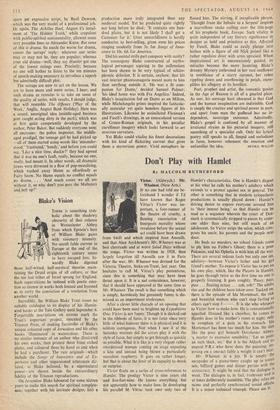Blake's Vision
Incredibly, the William Blake Trust issues no suitable catalogue to its display of his illumin- ated books at the Tate Gallery until September 6. Forgettable inscriptions on screens mark the Trust's important project, executed by the Trianon Press, of making facsimiles of Blake's unique coloured copy of Jerusalem and his other books 'illuminated' in watercolour. There is no similar instance of an author who illustrated his own works, then printed them from etched plates, and coloured them by hand as and when he had a purchaser. The rare originals --which include the Songs of Innocence and of Ex- perience and other impassioned utterances dic- tated, as Blake believed, by a supernatural power—are shown beside the extraordinary fidelity of the Trianon reproductions.
On Jerusalem Blake laboured for some sixteen years to make this search for spiritual complete- ness, together with his intricate designs, into a production more truly integrated than any medieval model. Yet he predicted quite rightly not long before he died: 'It contains one hun- dred plates, but it is not likely I shall get a Customer for it.' Utter unworldliness is hardly conducive to best-selling, given even his prices ranging modestly from 5s. for Songs of Inno- cence to 10s. 6d. for America.
Did his mental strife part company with sanity? The cosmogony Blake constructed of mytho- logical personages aspiring to the millennium has been shown to be very typical of schizo- phrenic delusion. It is certain, anyhow, that his vast interior phantasmagoria meant more to him than anything outside it. 'He was a fit com- panion for Dante,' decided Samuel Palmer; 'his ideal home was with Fra Angelico.' Indeed, Blake's imagination fed on Dante as on Milton, while Michelangelo prints inspired the fantastic- ally muscular yet quite boneless figures of his illustrations. Likewise he assimilated Flaxman's and Fuseli's drawings, in an emasculated version of Grreco-Roman originals, in his peculiar curvilinear imagery. which looks forward to art nouveau curvature.
Yet Blake could vitalise his finest decorations with his kind of flickering current that gives them a mysterious power. Vivid metaphors in- flamed him. The stirring, if inexplicable phrase, 'Thought froze the Infinite to a Serpent' inspires a marvellous snake coiling over the title-page of his prophetic book, Europe. Such vitality is quite independent of any literary significance in designs as bold and primitive as this. Affected by Fuseli, Blake could as easily plunge into bathos with a figure of old Nick poised like a rather repulsive diver with arms upraised. When inspirational art is unconsciously guided, its miracles become the more haunting. Blake's dreamy Mystery enthroned in her vast sunflower in semblance of a starry coronet, her robes rippling down and overflowing in petals, exem- plifies his allegory at its loveliest.
Poet, prophet and artist, the romantic genius in the Age of Reason is all of a gnarled piece. As seer, his message least obscured is that God and the human imagination are indivisible. God is simply the creative and spiritual power in man, and apart from man the godhead has no in- dependent, sovereign existence. Admittedly, Blake's gospel is confused by all manner of irrational strains in his pictorial imagery, still something of a specialist cult. Only his lyrical poetry still speaks to all, limpid and melodious in form, however vehement the emotion and




























 Previous page
Previous page